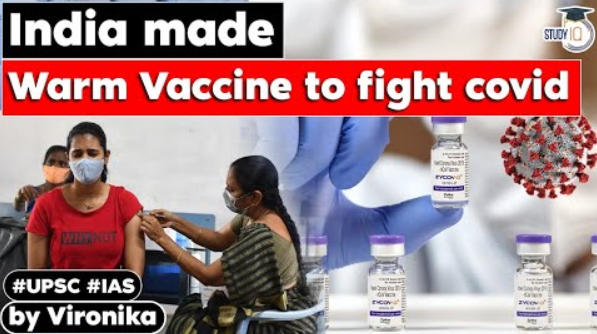Table of Contents
- A prospective vaccine against SarsCov2 being developed in India, that doesn’t need to be stored in refrigerators or cold-chain storage, generated a significant number of antibodies in mouse trials against prevalent variants of the virus, according to a study in the peer-reviewed journal

- The ‘warm’ vaccine developed by the Bengaluru-based Mynvax laboratories, a company incubated at the Indian Institute of Science Bangalore, is unique among existing vaccines in that it can be stored at 37 degree Celsius for four weeks and at 100 degree Celsius for upto 90 minutes.
- Most other vaccines require to be stored in refrigerators and can be kept at room temperature for no more than a few hours.
- In comparison, the Oxford-AstraZeneca vaccine, known as Covishield in India, must be kept between 2-8 degrees Celsius and the Pfizer preventive requires specialised cold storage at minus 70 degrees Celsius.


- However the test of a vaccine is whether it can elicit a sufficiently high antibody response out of the immune system and whether the vaccine was effective against variants: Alpha, Delta and Omicron.
- Existing vaccines have been developed on the template of the Wuhan strain whereas the prevailing variants have significant structural differences that improve their chances of evading the immune system-generated antibodies.

- The latest study, published recently in the journal Viruses, assessed vaccinated mice sera (blood samples) for efficacy against key coronavirus variants, including Delta and Omicron.
- The study found that mice immunised with different formulations of the vaccine elicit high titres (unit to measure amount or concentration) of antibodies that neutralise SARS-CoV-2 variants VIC31 (reference strain), Delta and Omicron variants of coronavirus.
- Compared to VIC31, there was an average 14.4-fold reduction in neutralisation against the Omicron variant for one formulation of the Mynvax vaccine and a 16.5-fold reduction for another formulation.
- The corresponding values for reduction in neutralisation against Delta variant were 2.5 and 3, according to the researchers.
- The heat tolerance of the vaccine and its ability to withstand transient thermal shocks is particularly promising to address the vaccine inequity that affects most low- and lower-middle-income countries, the researchers added.
- Over 10 billion doses of Covid-19 vaccines have been administered globally and 51 countries have reached more than 70 per cent of their population. However, this is only 11 per cent in low-income countries.
Challenges
- Vaccines that can withstand high temperatures are rare.
- Only three – offering protection against meningitis, human papillomavirus (HPV) and cholera – are licensed and approved by WHO for use at temperatures up to 40C.
- These vaccines can be deployed quickly in hard- to-reach communities, and reduce pressures on healthcare workers.
- They have proved to be useful during large-scale emergency responses like distributing oral cholera vaccine in Mozambique last year following Cyclone Idai, according to WHO.
How is it helpful?
- The possibility to transport vaccines outside the cold chain for the very last mile to reach the most remote populations in resource-limited settings is very helpful.
- It can be particularly helpful for mass vaccination campaigns when hundreds of thousands of vaccine doses need to be transported to several vaccination points within a short period of time
Challenges in Cold Chain
- To service this massive programme, India already has a robust network of state-owned cold storages for vaccines that can provide doses to more than eight million locations.
- Storing and keeping vaccines cool requires walk in freezers, ice-lined refrigerators, refrigerated trucks, coolant packs such as dry ice and cold boxes, which help in last-mile delivery. Nearly four million doctors and nurses are involved in the immunisation campaign.
- The WHO says Covid-19 vaccines under development can be categorised in three storage temperature requirements: 2-8C, -20C and -70C.
- A number of candidates, say experts, will require an “ultra cold chain” at temperatures which will “definitely prove a challenge to many countries.”

Question:
The first scientifically approved vaccine was…………………………
- a) Oral polio vaccine
- b) Smallpox vaccine
- c) MMR vaccine (measles, mumps, and rubella)
- d) Tetanus vaccine
Latest Burning Issues | Free PDF


























 WhatsApp
WhatsApp